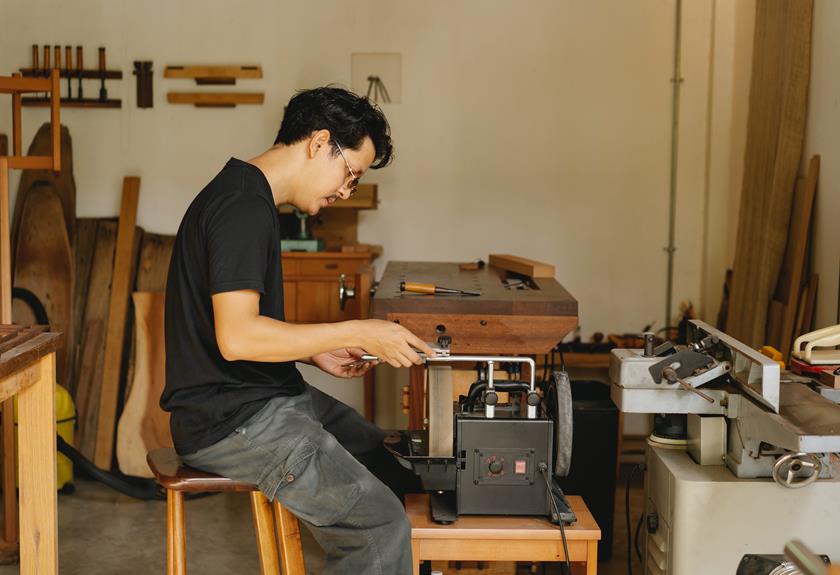Are you interested in woodworking? Whether you’re a beginner or an experienced woodworker, knowing the common joinery techniques is essential for creating strong and durable projects.
One example of a popular woodworking joinery technique is the mortise and tenon joint. This technique involves creating a hole (mortise) in one piece of wood and a corresponding protrusion (tenon) in another piece, which then fit together snugly. By using this joint, you can securely connect two pieces of wood at a right angle.
In addition to the mortise and tenon joint, there are several other commonly used joinery techniques that you’ll want to learn to expand your woodworking skills.
Key Takeaways
- The mortise and tenon joint is a time-tested technique for creating strong and durable connections in woodworking.
- The dovetail joint is an interlocking design that provides exceptional strength and durability, commonly used in furniture making and cabinet construction.
- The butt joint is a simple and versatile method for joining two pieces of wood end-to-end, ideal for simple woodworking projects and applications where speed and ease of assembly are important.
- The rabbet joint involves creating a recess or groove in one piece of wood to fit another piece, commonly used in cabinetmaking and bookcase construction.
Mortise and Tenon Joint
To create a strong and durable connection between two pieces of wood, you can use the time-tested technique of the mortise and tenon joint. This joint consists of a mortise, which is a cavity or hole in one piece of wood, and a tenon, which is a protrusion or tongue on the other piece of wood that fits snugly into the mortise. There are variations of the mortise and tenon joint, including the through mortise and tenon, where the tenon passes all the way through the mortise, and the blind mortise and tenon, where the tenon isn’t visible from the surface of the wood.
To create a strong mortise and tenon joint, follow these tips:
- First, ensure that the mortise and tenon are cut to precise measurements, with a tight fit that doesn’t require excessive force to insert.
- Next, make sure that the mortise and tenon are perfectly aligned to achieve maximum strength and stability.
- Additionally, use a strong adhesive, such as wood glue, to further reinforce the joint.
- Finally, consider adding wooden pegs or dowels through the joint for added strength and a decorative touch.
Now, let’s move on to the next woodworking joint, the dovetail joint.
Dovetail Joint
Now, let’s delve into the dovetail joint, a versatile and popular woodworking technique that builds upon the strength and precision of the mortise and tenon joint.
The dovetail joint is known for its interlocking design, which provides exceptional strength and durability. This joint is commonly used in furniture making, cabinet construction, and box making. The unique shape of the dovetail joint allows for a strong bond between two pieces of wood without the need for additional fasteners such as nails or screws.
There are several variations of the dovetail joint, each suited for different applications. The most common variation is the through dovetail joint, where the tails extend all the way through the thickness of the adjoining piece of wood. This type of joint is often used in drawer construction, as it provides a visually appealing and sturdy connection.
Another variation is the half-blind dovetail joint, which is commonly used in drawer fronts. In this joint, the tails aren’t visible from the front, creating a seamless and aesthetically pleasing appearance.
The dovetail joint requires precision and skill to create, but the end result is a strong and visually striking connection.
Now, let’s move on to the next woodworking technique, the butt joint, which is a simple yet useful method for joining two pieces of wood.
Butt Joint
The most common woodworking joint technique is the butt joint, which involves joining two pieces of wood end-to-end using a simple and straightforward method. Butt joints are widely used in woodworking projects due to their ease of construction and versatility.
Here are four important points to consider about butt joints:
- Strength and stability: Butt joints may not be as strong or stable as other joinery techniques, such as dovetail or mortise and tenon joints. However, when properly reinforced with additional methods like screws or dowels, butt joints can still provide sufficient strength for many applications.
- Types of butt joints: There are different types of butt joints, including plain butt joint, mitered butt joint, and edge-to-edge butt joint. Each type has its own specific applications. For example, the mitered butt joint is commonly used to create clean and seamless corners, while the edge-to-edge butt joint is ideal for joining boards side by side.
- Applications: Butt joints are commonly used in simple woodworking projects, such as building cabinets, shelves, and basic furniture. They’re also frequently used in construction work, where speed and ease of assembly are crucial.
- Reinforcement methods: To enhance the strength and stability of butt joints, additional reinforcement methods can be used. These include using glue, screws, dowels, or biscuits to provide additional support and prevent the joint from coming apart.
Rabbet Joint
When using the rabbet joint technique, you create a recess or groove in one piece of wood that allows another piece to fit into it. This joint is commonly used in cabinetmaking and bookcase construction.
There are two main types of rabbet joints: the simple rabbet joint and the double rabbet joint.
The simple rabbet joint involves cutting a groove along the edge of one piece of wood, allowing the second piece to fit snugly into it. This joint is quick and easy to make, making it a popular choice for many woodworkers. However, it may not provide the same level of strength as other joint types.
On the other hand, the double rabbet joint is made by cutting a groove on both pieces of wood that are being joined together. This creates a stronger joint, as there’s more surface area for the pieces to interlock. However, it requires more precision and careful measurement to ensure a proper fit.
The advantage of using a rabbet joint is that it provides a flush and seamless appearance when the pieces are joined together. This joint type is also effective in preventing the wood from warping over time. However, it may not be as strong as other joint types, such as the dovetail joint or the mortise and tenon joint.
Now, let’s move on to the next joint technique, the miter joint.
Miter Joint
To create a miter joint, you often use a miter saw and make precise cuts at a 45-degree angle on the ends of two pieces of wood. This technique allows you to join two pieces of wood at a corner, creating a seamless and visually appealing joint.
Here are some tips for achieving a tight and seamless miter joint in your woodworking projects:
- Ensure precise measurements: Accurate measurements are crucial when creating miter joints. Use a reliable measuring tool and double-check your angles before making any cuts.
- Use a sharp blade: A sharp blade will make clean and precise cuts, resulting in a tight fit between the two pieces of wood.
- Practice proper assembly: Apply glue evenly to both mitered surfaces and use clamps to hold the joint together firmly while the glue dries. This will ensure a strong bond and prevent any gaps from forming.
- Consider the pros and cons: Miter joints offer a clean and seamless look, making them ideal for projects that require a polished finish. However, they can be weaker than other joint types, so consider the strength requirements of your project before choosing a miter joint.
Frequently Asked Questions
How Do I Determine Which Woodworking Joint Is Best for My Project?
To determine the best woodworking joint for your project, consider factors like the type of wood, load capacity, and aesthetic appeal. Ensure strength and durability by using appropriate joinery techniques and reinforcing the joint if necessary.
What Are Some Alternative Joinery Techniques That Can Be Used Instead of the Traditional Methods Mentioned in the Article?
You can explore alternative joinery techniques to add uniqueness to your woodworking projects. Using non-traditional methods brings benefits like increased strength, aesthetics, and creativity. Experiment with different options and expand your woodworking skills.
Are There Any Specialized Tools or Equipment Required for These Woodworking Joints?
You’ll need some fancy tools for those woodworking joints! Precision is key, so don’t skimp on the specialized equipment. But hey, at least you’ll feel like a pro with all the gadgets!
Can These Joinery Techniques Be Used on Different Types of Wood, or Are They Specific to Certain Wood Species?
You can use different types of wood for joinery, but each has its pros and cons. Some woods are stronger and more durable, while others may be easier to work with. Tips for strong joinery include selecting the right wood and using proper techniques.
Are There Any Common Mistakes or Challenges That Beginners Typically Encounter When Attempting These Woodworking Joints?
When you delve into woodworking, you might encounter a few challenges. Beginners often make common mistakes when attempting woodworking joints. But fear not! With practice and patience, you can overcome these hurdles and master the art of joinery.
Conclusion
So there you have it, folks.
After all the meticulous planning and careful craftsmanship, you’ve finally mastered the art of woodworking joinery.
Now you can confidently create stunning pieces that will surely fall apart at the slightest touch.
Yes, your beautifully ironic creations will leave everyone in awe as they crumble into a pile of mismatched wood.
It’s a true masterpiece, isn’t it?

I’m James Brown, the founder and editor of DIYINUSE.COM. I have over 15 years of hands-on woodworking and DIY experience that I share through tips and project inspiration on my website. When I’m not working on home improvement projects or creating content for the site, I enjoy spending time outdoors hiking and fishing. I’m always looking to expand my creativity and DIY skills by learning new techniques.
